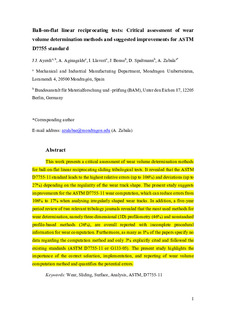Izenburua
Ball-on-flat linear reciprocating tests: Critical assessment of wear volume determination methods and suggested improvements for ASTM D7755 standardArgitalpen data
2021Beste erakundeak
Bundesanstalt für Materialforschung und -prüfung (BAM)Bertsioa
PostprintaDokumentu-mota
ArtikuluaArtikuluaHizkuntza
IngelesaEskubideak
© 2021 Elsevier B.V.Sarbidea
Sarbide irekiaBahituraren amaiera data
2023-04-30Argitaratzailearen bertsioa
https://doi.org/10.1016/j.wear.2021.203620Non argitaratua
Wear Vol. 470–471. N. artículo 203620, 2021Argitaratzailea
Elsevier B.V.Gako-hitzak
Wear
Sliding
Surface
Analysis ... [+]
Sliding
Surface
Analysis ... [+]
Wear
Sliding
Surface
Analysis
ASTM D7755-11 [-]
Sliding
Surface
Analysis
ASTM D7755-11 [-]
Laburpena
This work presents a critical assessment of wear volume determination methods for ball-on-flat linear reciprocating sliding tribological tests. It revealed that the ASTM D7755-11 standard leads to the ... [+]
This work presents a critical assessment of wear volume determination methods for ball-on-flat linear reciprocating sliding tribological tests. It revealed that the ASTM D7755-11 standard leads to the highest relative errors (up to 106%) and deviations (up to 27%) depending on the regularity of the wear track shape. The present study suggests improvements for the ASTM D7755-11 wear computation, which can reduce errors from 106% to 17% when analysing irregularly shaped wear tracks. In addition, a five-year period review of two relevant tribology journals revealed that the most used methods for wear determination, namely three-dimensional (3D) profilometry (46%) and nonstandard profile-based methods (36%), are overall reported with incomplete procedural information for wear computation. Furthermore, as many as 8% of the papers specify no data regarding the computation method and only 3% explicitly cited and followed the existing standards (ASTM D7755-11 or G133-05). The present study highlights the importance of the correct selection, implementation, and reporting of wear volume computation method and quantifies the potential errors. [-]





















